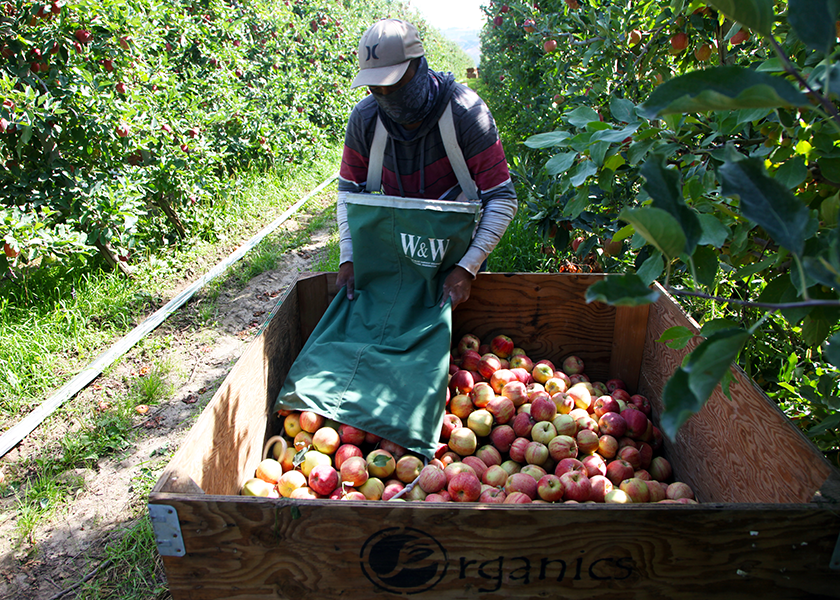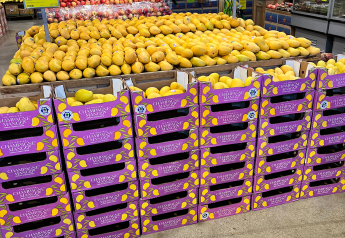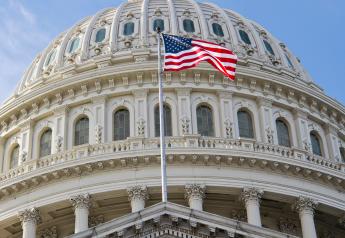Stars align for stellar Washington apple crop

With fall fast approaching, all eyes are on Washington to see what fruit the nation’s top apple-producing state will bear this season.
Washington’s 2023 crop is estimated at nearly 160 million bushels and valued at more than $2 billion — 9% higher than last year, according to USApple, a Falls Church, Va., nonprofit industry association, which finds Washington accounts for 63.8% of U.S. apple production and 67.5% of the value.
Let’s it hear it for the bumper crop.
This year has been particularly favorable for apple growing, said Brianna Shales, marketing director for Stemilt Growers, Wenatchee, Wash.
“In 2022 we had every weather that could happen — snow during bloom, multiple hail events — so it led to a challenging year,” she said. “This year it’s the complete inverse of that; we had really warm weather during bloom then a very nice moderate summer with not many days 100 degrees-plus. So, we’re seeing great size and color.”
Thanks to the favorable weather, Washington is expecting to produce nearly 130 million cartons of apples this year, according to the Washington Tree Fruit Association. This is a significant increase over last year when the state produced close to 100 million cases.
“We couldn’t have asked for better weather this year for growing apples,” said Rochelle Bohm, vice president of marketing for CMI Orchards in Wenatchee. “You want it to be 80 to 90 degrees, then really cool nights, and that’s how you get crispness in the fruit. A wide temperature spread between day and night is ideal, and we’ve had one of the best weather years we’ve had in a long time.”
The size of apples is larger for some. Domex Superfresh Growers in Yakima, Wash., expects to be up two sizes from last year, said Cat Gipe-Stewart, director of marketing.

Retail is ready
The Skagit Valley Food Co-op in Mt. Vernon, Wash., sells about a dozen varieties of Washington apples in the fall, with four varieties available year-round.
And while this is fewer varieties than the retailer has carried in the past, “it’s starting to come back,” said Ben Goe, produce manager.
Washington’s fuji apple is the best seller year-round due to its price, which is often $1.49 per pound and sometimes as low as 99 cents per pound, he said, compared with $3.49 to $3.99 for other varieties. The apples are all organic.
Every month the retailer stocks fuji, gala, Pink Lady and granny smith apples, though it carries many more in the fall. Cosmic Crisps, which were developed in Washington state and have been available since 2019, are quickly gaining in popularity, Goe said. In the past year they were available for around eight months, but they will probably be available 12 months a year soon since they store well, he said.

A glut of options
Washington is home to more than 30 varieties of apples — some of them year-round mainstays, some more experimental new varieties, and others that fall somewhere in between. Of these apples, 72% go to the fresh market, according to USApple.
The state’s most popular apples are gala, Honeycrisp, red delicious and fuji, says Brian Bernard, export and import department manager for Bloxom Co., a Seattle-based distributor and exporter.
There are in-demand apples beyond the standard varieties. Stemilt’s Rave and SweeTango arrive early “and help kick off apple season,” Shales said. Rave is followed by SweeTango, which “are great apples for building velocity when other varieties haven’t quite come back into season,” she said.
Cosmic Crisp is a recent star available to all Washington growers, Shales said.
“I expect it to be in the top 10 apple varieties in the U.S. because of the volume that’s been planted and now come into production,” she said.
Though Cosmic Crisps are only grown in Washington, they’re sold across the country, as well as in Canada and Mexico, Shales said.
Cosmic Crisp demand exceeds supply, said Gipe-Stewart of Superfresh Growers, who added that consumer demand lasts all year.
“We are still working through storage fruit and eagerly wait for Dec. 1 shipment dates for the 2023 crop,” she said.
Another variety to watch, but not yet in heavy production, is the EverCrisp, said Goe of the Skagit Food Valley Co-op. This year will the fourth the store has offered this variety.
“It’s incredibly dense and hard as a rock. It’s got enough acid to balance the flavor,” Goe said of the apple, which is a Honeycrisp-fuji cross.
CMI Orchards grows all the favorites, but its bestsellers are ambrosia, Cosmic Crisp and Envy apples, which it sells to every U.S. state and 80 countries. “We have year-round availability,” Bohm said.
Top-selling varieties for Sage Fruit Co., Yakima, are Honeycrisp, gala, fuji, granny smith and Pink Lady; the company, which is the sales and marketing firm for five grower-packer-shippers in the Pacific Northwest, said it continues to see an increase in popularity of Cosmic Crisp and SugarBee apples.

Consumer preferences
Most Americans eat apples, and texture is the most important factor, Shales said.
“It starts with the texture; the thin skin with Honeycrisps has become the bar for other apples to meet,” she said.
But apples can’t rely on texture alone. Flavor is also important, and the combination of sweet and tart is most appealing, she said.
Consumers are always looking for new apple varieties, Shales adds, and Stemilt’s goal is to plant not just more apple trees, but the best ones.
“First, we test new varieties to see if they have the qualities it would take to compete in the marketplace,” she said. “We’re not necessarily expanding a whole bunch of different varieties but being selective about choosing the best ones that will be above and beyond the Honeycrisp expectations consumers have.”
Stemilt has been looking to develop a new yellow apple to replace the long-standing golden delicious. So, last year it had the Aura for the first time. It has the Honeycrisp-type texture “and its flavor is amazing — mellow like a golden but with unique flavor notes,” Shales said.
Consumers want sweet and crisp apples, said Bohm of CMI Orchards.
“They want to hear that crack when they bite in. The third piece is flavor, and we’re starting to take cues from the wine industry: What are the flavors and the subtle undertones of apples?” Bohm said. “Our SugarBee apples have notes of honey, caramel and subtle molasses flavors.”
The company has created a website (flavogram.com) featuring flavor profiles for apple varieties.
It’s all about balance and texture, Goe said. Consumers are looking for crunch, which often comes from the density of the flesh (Honeycrisps are very dense.) and the grain. While the Honeycrisp has a coarse grain “what people are dialing into is these finer-grain apples like Cosmic Crisp and EverCrisp and the Pink Lady,” he said.
And while pricing helps sell apples, they also want “complexity, texture and a sweet-tart balance,” Goe said.

Apples at retail
In its work with retailers, Stemilt finds the most effective move for grocers is to run multivariety ads.
“Apples, which are available all year, need prominent placement, and they need it monthly,” Shales said. “What we like to see is not [just] promoting one or two apples, but three to five varieties at a time, because that helps elevate the whole category, not just those varieties.”
Consumers want information about the flavor profile of apples and what’s unique about the new varieties, Shales said. “They also want to know if they can substitute what they buy for another variety.”
It’s important to let consumers know which varieties they can bake with and how they can incorporate apples into their snacking occasions, she said. Plus, more consumers want to know about the people who grow their food and to understand the story of where it comes from.
The Skagit Valley Food Co-op highlights apples on sale by moving them to a bin next to the registers up front. On a daily basis, it provides information on farms and farmers and especially highlights any apples it buys directly from farmers, with a tag on each apple.
It includes information in a newsletter and on its website, but the best thing the store can do, Goe said, “is to have knowledgeable staff.” During apple season, the store places a chart next to the apple display explaining which apples are sweeter, tarter, better for cooking, and so on.
Specific varieties are doing special advertising, too, says Audrey Desnoyers, director of business development and key account management with Oppy, a grower, marketer and distributor based in Vancouver, British Columbia. Jazz apples will soon run a Halloween “It’s Boo Time!” campaign featuring eye-catching POS and Kwik Lok tags that include fun recipes and using big displays showcasing its high-graphic boxes and online presence.
The Envy apple, which has had successful holiday campaigns with the Hallmark Channel, has teamed up with actor-producer Andrew Walker for a strategically aligned partnership throughout the year, says the brand.
Cross-merchandising is also a great tactic for apples “with such items as peanut butter, dips, cheese and other produce items that encourage purchase, especially during key entertaining periods,” Desnoyers said.
CMI Orchards provides POS merchandising to stores.
“We know how tough labor is these days, so we have tools that ship with the apples to make it quick and easy to set up and create an impactful display for selling,” Bohm said. The orchards also provide 7-by-11-inch cards that slide into the pricing channels. “It’s getting tougher to get floor displays, so we’re using more QR codes on our products so we can share information without billboards in stores.”
To get information to consumers quickly, CMI Orchards has created a color bar to show how sweet, tangy or mild an apple is.
“It’s like a flavor rainbow, and they don’t need to read anything,” Bohm said.
The company includes it on packaging, and it can even help consumers trade up and bring more revenue for the retailer, she said.
Sage Fruit Co. says it helps retailers build eye-catching displays to grab consumers’ attention; it also provides information on flavor, availability and best uses.
“Retail displays must appeal to the consumer, whether they catch their eye by color and size or the presentation of new varieties and flavor profiles being offered,” said Kaci Komstadius, vice president of marketing. “High-graphic, clean packaging can help in catching the consumer’s attention as well.”
Superfresh Growers supports its Autumn Glory and Cosmic Crisp apples with social media, digital streaming ads and influencer campaigns, Gipe-Stewart said. It suggests promoting Honeycrisp and Cosmic Crisp together or in alternating advertisements.
Packaging solutions
While many Washington apples are sold loose, packaged brands are “a growing area for the category,” Shales said. Stemilt has recently started using the EZ Band, a four-pack package for apples that’s made completely of paper and is 100% recyclable.
“This provides a solution that is scannable and easy for retailers to stock, easy for shoppers to shop, and easy on the earth,” Shales said.
The package has a lot of value, especially for organics, which are often incorrectly rung up as conventional at self-checkouts, she said.
“Bulk apples will always have a place on the shelf, which is how we pack a majority of our product — in 40-pound tray-pack boxes,” Komstadius said. “However, the No. 1 packaging trend over the past two years has been high-graphic pouch bags, and more specifically, private-label pouch bags. Due to the demand for high-graphic pouches, we have integrated several packaging weights to accommodate our partners, including a 2-pound, 3-pound and 5-pound pouch.”
However, she points out, “as the focus on sustainability increases, we may see a decrease in demand for pouch bags over the next few years as retailers and suppliers work towards more environmentally friendly packaging.”
CMI Orchards’ products are typically bulk and come in standard cartons, pouches and poly bags. The company also is doing some packaging with Top Seal, a plastic tray and cover, which uses about 30% less plastic compared with a clamshell.
As part of its focus on sustainability, CMI Orchards said it is testing recyclable plastics and exploring additives that can go into the plastic so it will break down completely in two to five years.
The company features QR codes on packaging that explain its composition. Consumers can scan the QR codes for more information, “even getting into the weeds of the chemistry and technology of that specific package,” Bohm said. “We’re all about transparency; we’re very proud of the packages we have chosen to bring to market. We have some great innovations that are super earth friendly that are real solutions, not greenwashing solutions.”
Sustainable packaging is also top of mind at Superfresh Growers.
“Sustainability is key and continually requested by consumers,” Gipe-Stewart said. “Ultimately, the most sustainable packaging option is bulk ... [but] the poly bag continues to be one of the simplest and best options; in addition to being fully automated, it is also continuously recyclable via store drop-off and has a much smaller carbon footprint than paper or compostable packaging.”
Going organic
Organic apple demand remains high and should continue that way, Komstadius said.
“Roughly 52% of organic consumers are millennials, and they account for 30% of the U.S. population,” she said. “The majority of millennials who are purchasing organic items are also parents. Our organic program will continue to grow over the next several years to meet demand. Not only are we planting new acreage of organic orchards, but we are actively transitioning many of our conventional orchards.”
Sage Fruit Co.’s most sought-after organic item by retailers is organic Honeycrisp, but organic gala and fuji “don’t fall too far behind,” Komstadius said. “Organic Honeycrisp is a high-end consumer favorite, which has an excellent ring at the register. On the opposite side of that though, organic gala and fuji are an excellent option for the everyday, organic consumer because they are more price-friendly.”
This season the grower expects to see an increase in organic SugarBee volume.
Sixteen of CMI Orchards’ 19 varieties have organic versions, or between 15% and 20% of the crop “and demand seems to be increasing,” Bohm said. “It’s a bright spot in the category and a great way to drive income because retailers can drive sales from the small pricing lift.”
The grower is transitioning some fields, and some new plantings are organic, she added.
Stemilt markets its organic apples under the Artisan Organics brand, and nearly 30% of its apples are certified organic, with more on the way.
“We are strategically growing certain varieties organically, with Honeycrisp, Cosmic Crisp and SweeTango being the main drivers of growth,” Shales said.
Challenges in the field
Labor continues to be a challenge for Washington apple growers.
“We are trying to hire as many people as we can, but installing one robot on our packaging line could remove three people, and then the machine is paid for in the year, which makes it incredibly enticing to move in that direction,” Bohm said.
Beyond labor shortages, additional challenges include H-2A overtime laws, “which make it very difficult to keep an active workforce going,” she said.
“Washington apple producers face substantial challenges,” Desnoyers said. “Soaring input costs, inflation, adverse weather and labor shortages create a tough financial balance.”
Another challenge is competition from other growing areas throughout the world, says Bloxom’s Bernard.
“For example, India looked to other markets such as eastern Europe and the Middle East for apples when the tariff on U.S. apples jumped a few years back,” Bernard said. “The additional U.S. tariff was recently rescinded, however; U.S. apples now have apples from other growing areas to compete with.”
Despite that, the future is bright, crunchy and crisp for Washington apples as more varieties come to market and those that are available become household names. Consumers’ desire for something new, coupled with their desire for comfort, mean apples will remain in the sweet spot.







